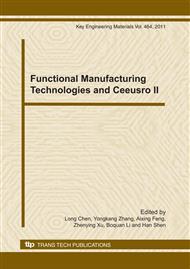p.681
p.686
p.690
p.694
p.698
p.703
p.708
p.712
p.717
Optimization of Process Parameters for Vacuum Casting Micro-Gear
Abstract:
A silicone mould fabrication technique based on vacuum casting was developed and its reproducibility was demonstrated. Orthogonal DOE method was adopted to analyze the effects of vacuum casting process parameters, and the process parameters that had an influence on the quality of the micro-mould cavities were identified and optimized. Micro-casting experiments were carried out using the optimized process parameters and the replicated micro-gears were obtained, these silicone copies were subjected to thorough analysis for dimensional accuracy against the master pattern. The results showed that the fabricated micro-mould was capable of producing functional micro-parts that were able to replicate micro-features, and micro-gears were successfully transferred from the silicone rubber moulds into PU resin pieces under vacuum conditions.
Info:
Periodical:
Pages:
698-702
Citation:
Online since:
January 2011
Authors:
Price:
Сopyright:
© 2011 Trans Tech Publications Ltd. All Rights Reserved
Share:
Citation:


